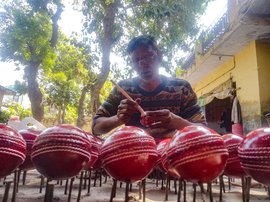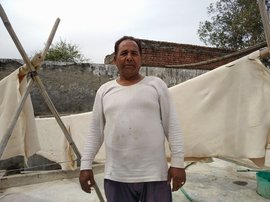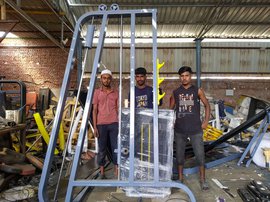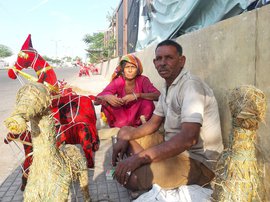Five karigars in a carrom board karkhana (factory) in Meerut work eight hours on five consecutive days to ready a batch of 40 boards. Each of the craftsmen in this workshop knows all that it takes to make the striker and coins shuttle swiftly between a carrom board’s frame. It’s a game that supports a maximum of four players – but there are five artisans here working on each board. They help make the sport of carrom possible, but have never played it themselves.
“I have been making carrom boards since 1981, but I have never bought a board or played carrom. Where is the time to spare?” asks 62-year-old Madan Pal. Even as we’re chatting, he and his fellow karigars (craftsmen) meticulously arrange 2,400 dandas or cut pieces of babool wood. These are each of 32 or 36 inches length and the workers lay them out in the galli (lane) along the outside wall of the workshop .
“I reach here by 8:45 a.m. and we start work by nine. By the time I am home, it is 7-7:30 in the evening,” says Madan Pal. ‘Here,’ is the tiny carrom board factory in Suraj Kund Sports Colony in Meerut city, Uttar Pradesh.
Madan leaves his home in Puttha village, Meerut district, at seven in the morning, six days a week, to travel 16 kilometres on cycle to his workplace.
Two transporters on a chota hathi (literally, small elephant – actually, a mini tempo truck) have just delivered those cut pieces of wood from the sawmills in Tarapuri and Islamabad localities of Meerut city.
“These pieces will
form the outer frame of carrom boards but first they have to be kept out to dry
in the open for four to six months. Air and sun drying makes the pieces
moisture free, keeps them straight and prevents fungus growth,” Madan explains.


Left: Karan inspects each danda (stick) and segregates those that are damaged to return them. Right: Madan (white shirt) and Karan (blue shirt) arrange the 2,400 sticks in the lane outside the workshop
Karan, 32, (he goes only by that first name) who has been working here for 10 years, inspects each stick of wood and segregates those that are damaged and will be returned. “After these dry, we will send them back to the aara machine waale [sawmill owners] for cutting a step or level on the inside of each stick and for slanting its ends,” he says.
“The plyboard playing surface sits on the second level that is cut off, which is around two centimetres below the frame where players position their wrists and palms. This creates boundaries that let the coins shuttle from one side to another without falling off the board,” Karan explains. “It is not difficult to make a board, but it is not easy to make the coins glide on the playing surface,” he adds.
“The standard size of the playing surface is 29 x 29 inches, and with the frame, the board comes to be around 32 x 32 inches,” says Sunil Sharma, 67, owner of this karkhana . “These are used for official competitions. But we make boards based on orders and sizes that can range from 20 x 20 inches used mostly by children, up to 48 x 48 inches. Four main things are required to make a carrom board,” he explains. “The babool wood frame; the plyboard for the playing surface; a back support of teak or eucalyptus wood [ chakdi ] that holds the plyboard in place; and crochet coin pockets. Each of these is sourced locally,” he adds. Some of his suppliers, though, source their material from other states.
“In 1987, two expert carrom makers — Ganga Veer and Sardar Jitender Singh — taught me the nitty gritty of this craft. Before that we used to make badminton rackets and cricket bats,” he recalls.
Sharma walks from his
one-room office at the workshop
entrance to where the craftsmen are
arranging the wooden sticks in stacks. “We make carrom boards in lots
of 30-40 units which take about 4-5 days to get ready. Right now, we have an
order for 240 export pieces from a trader in Delhi. We have readied and packed
160 of them till today,” he says.


Left: Sunil Sharma, owner of the karkhana , with a finished carrom board. Right: Carrom boards in various stages of production
Since 2022, Indian carrom boards have been exported to 75 countries and territories across the globe. According to the Export Import Data Bank of the Union Ministry of Commerce and Industry, the value of exports between April 2022 and January 2024 was close to Rs. 39 crores. The highest returns were from the USA, Saudi Arabia, UAE, UK, Canada, Australia, Yemen, Nepal, Belgium, Netherlands and Qatar (in that order).
Those export earnings came from close to a million carrom boards bought overseas, including in archipelagos of the Indian Ocean like Comoros and Mayotte, the Fiji Islands in the Pacific Ocean, and Jamaica and St. Vincent in the Caribbean.
The highest number of carrom boards were imported by UAE, followed by Nepal, Malaysia, Saudi Arabia and Yemen.
There are no records available for domestic sales. If there were, the numbers would surely be mind boggling.
“During Covid-19 we had abundant domestic orders because everyone was locked in at home. They needed to kill their boredom,” Sunil Sharma says. “Another pattern that I have observed,” he adds, “is an increase in demand from Gulf countries just before the month of Ramzan.”
“I have played a lot of carrom myself. This game is mostly popular as a pastime,” Sharma says. “But,” he adds, “there are formal domestic and international tournaments as well, which are not live telecast like matches in other sports are.”

Inside the karkhana where carrom boards are made
'We make carrom boards in lots of 30-40 units which take about 4-5 days to get ready. Right now, we have an order for 240 export pieces from a trader in Delhi. We have readied and packed 160 of them till today,' says Sunil Sharma
Formal carrom-related activities in India are controlled and supervised by the All India Carrom Federation (AICF) through its affiliated state and district associations. The AICF, established in 1956 and based in Chennai, is affiliated to the International Carrom Federation and the Asian Carrom Confederation. The AICF prepares and deputes the Indian contingent to all international tournaments.
Though global
rankings are not quite as systematised and clear as in other sports, India is
certainly among the very top carrom-playing nations. Rashmi
Kumari of India is widely acknowledged to be the reigning world champion in women’s
carrom. And there is 68-year-old A. Maria
Irudayam from Chennai, two-time men's World Carrom Champion and nine-time
National Champion. Irudayam is the only Indian sportsperson to have received
the Arjuna Award for carrom. That was over a quarter of a century ago – in
1996. The Arjuna Award, India's second-highest sporting honour, is awarded
annually.
*****
Seated on his haunches on the karkhana floor, Karan has four dandas lying just beside him, each of which he grips in turn under one foot while fastening its slanting ends to make a square frame. He hammers eight corrugated iron fasteners, locally called kanghi (comb), to join the four corners. “ Keel se behtar join karti hai kanghi [the kanghi joins the corners better than nails],” Karan says.
Once the frame is fixed, Amarjeet Singh, 50, rounds its edges using a reti (metal file). “I used to have a dairy business which became unprofitable, so I started making carrom boards here three years ago instead,” he says.
Tiny shards of wood have remained on the surface of the frame after it was step-cut in the sawmill. Amarjeet then applies marammat , a beige-coloured paste-like mixture of chalk mitti (chalk powder) and a wood adhesive called Movicol, all over the frame’s surface using a lohe ki patti (small, flat iron file) .
“This fills up the
gaps in the uneven wood surface, and also flattens the shards of wood,” he
explains, and adds, “The paste is called
baroode ki
marammat
.”
Once the paste dries, only the step on which the plyboard playing surface will
be made to sit is filled with a layer of black
marammat
.


Karan holds four dandas by foot as he fastens their slanting ends to make a square frame. He then hammers eight kanghis (corrugated iron fasteners) to join the four corners


Once the frame is fixed, Amarjeet Singh rounds the edges using a reti (filer). Then, he applies a beige-coloured marammat (paste) of chalk mitti and movicol, a wood adhesive over the frame's surface using a flat iron file
Then a coat of fast-drying, water-resistant, black Duco paint is applied on the step within the board’s borders and is smoothened after it dries with regmal (sandpaper). “This part of the frame becomes inaccessible once the plyboard is fitted onto it, so it has to be readied earlier,” Amarjeet says.
“We are five karigars here and all of us are experts at all the tasks involved,” says Dharam Pal, 55. He has been working at this workshop for the last 35 years.
“Whenever we get an order of any number, the first thing we do is prepare the plyboard playing surface,” says Dharam as he, Madan and Karan bring out the readied ones that will be fixed onto the frames. “We apply a sealer all over the surface to fill the pores of the plyboard which also makes it waterproof. After that we smoothen it with sandpaper,” he explains.
“Plyboards are very rough and the main attraction of a carrom board is how smooth the playing surface is. The carrom coins should move swiftly from here to there,” says Sharma mimicking the movement of coins with his index finger and head. “We use either mango face or makai tree face plyboard that local traders procure from Kolkata,” he adds.
“When we had started off in 1987, the markings on the playing surface were hand-painted. The work was intricate and time consuming. Back then, an artist was an important member of the team , ” Sunil recalls. “But today, we can quickly screen print the playing surfaces one after the other,” he says, pointing towards the square screens hanging on the high walls of the workshop . It also means the artist has disappeared here, as in most of the sports equipment industry, in the past three to four decades.
Screen printing is a
stencilling technique that blocks paints from passing through certain areas
while making them pass through required ones. “We use two different screens on
each surface. The first one for the red markings, and the second for the
black,” says Dharam Pal. For the current order of 240 carrom boards, the
markings on all plyboards have already been made.


Dharam, Madan and Karan (left) bring out screen-printed plyboard surfaces that will be fixed onto the frames. Different-sized screens (right) of carrom board


Left: Steel pot and glasses in which the workers have tea. Right: Rajender and Amarjeet clear some space on the factory floor and spread a thin blanket over which they lie down for 12-15 minutes during lunch break
It is 1 p.m. now, and the karigars break for lunch. “It is an hour’s break, but they get back to work at 1:30 p.m. so that they can leave half an hour early in the evening by 5:30 p.m.,” says owner Sunil Sharma.
The workers carry packed lunches and have a quick bite in the backyard of the premises, amidst drying pieces of wood, just on the edge of a malodorous open and flowing drain. Rajender Kumar, 50, and Amarjeet clear some space on the floor and spread a thin blanket over which they lie down for 12-15 minutes. Before they can fall asleep, it is time to get up.
“ Bass peeth seedhi karni thi [just needed to rest my back for a while],” Amarjeet says. They quickly drink sips of milk tea brought from a nearby stall in a steel kettle in their respective stainless steel tumblers. Then it’s back to work.
With the plyboards already prepared, the next step is to paste a chakdi onto each. “A chakdi forms the back support of a plyboard,” explains Rajender who has been working here 20 years. “It is made by nailing and pasting thin strips of teak or eucalyptus wood to form a pattern of intersecting vertical and horizontal lines.
Iss kaam ke pehle main deewar ki putaai karta tha [I used to whitewash walls before this],” he adds.
“We purchase our
chakdis
from Muslim
karigars
in the Mehtab Cinema area in Kesarganj. There are
woodworkers in Meerut who are
chakdi
specialists only,” says Sunil Sharma.


Rajender and Madan apply fevicol (left) on the 40 chakdis between them using a thick paint brush. Karan is in-charge of picking up chakdi after chakdi (right) and pasting printed plyboards onto them
Rajender sits opposite Madan on the same place where he was lying down a little while earlier. Between them is a pile of 40 chakdis on which they apply Fevicol, one after another, with a thick paint brush. Karan, who is more agile given he is the youngest karigar, is in charge of the task of picking up chakdi after chakdi and pasting plyboards onto them.
“We usually do chakdi chipkana at the end of the workday. I am putting the plyboards upon each other and then we will keep a heavy object on the topmost piece and leave it overnight, so that it sticks properly,” Karan explains.
It is 5:15 p.m. now.
The
karigars
hasten to finish their tasks. “Tomorrow morning, we will
fix the plyboards on the frames.” Karan says. “My father too was a sports goods
karigar
in another
karkhana.
He used to make cricket bats and
stumps,” he adds.
*****
Work begins at 9 a.m. sharp the next day. After having their tea, Rajender, Madan, Karan and Dharam take up positions next to their tables inside the karkhana to perform three linear tasks. Amarjeet is working on filing frame edges in the galli outside.
Karan and Dharam together begin by fixing the plyboard- chakdi combines onto the joined, filed and painted frames one by one. Each of them is in charge of hammering nails at pre-determined spots on the chakdi on their respective sides of the board.
“As many as four
dozen small nails are required to fix one board onto the frame,” Dharam says. Astonishingly,
just two of the workers hammer in those 48 nails in roughly 140 seconds before
they place the fixed board against the pillar close to Madan’s workstation.


Karan and Dharam fix the plyboard-chakdi combines onto the joined, filed and painted frames
Today, Madan is in charge of cutting out coin pockets at the four edges of the carrom board. The diameter of the pocket cutter is set to four centimetres which is made to work with the same technique as a compass in a school geometry box.
“I am the only member of my family who is a sports goods karigar . I have three sons. One runs a shop, one is a tailor, and one is a driver,” Madan says as he bends over the board to press the blades of the cutter and rotate its handle simultaneously. He takes just around 55 seconds to cut four pockets. This time does not include the few minutes spent on lifting, turning, and arranging a six to eight-kilogram board from one place to another.
After cutting the pockets he keeps each board next to Rajender’s table who takes them one by one to apply a layer of marammat paste on the frame with a lohe ki patti for the second time . When he looks down at the board to spread the marammat , he draws my attention to the playing surface, “See, the board is reflecting my fingers like a mirror,” he says.
“At this stage the
board is visually ready, but a lot of work is still left before it becomes prepared
and set for play,” owner Sharma says. “For today our target is to finish one
layer of
marammat
on all 40 frames. We’ll undertake the finishing
processes on the frames tomorow morning,” he adds.


Madan is in-charge of cutting out coin pockets at the four edges of the carrom board. The diameter of the pocket cutter is set to four centimetres


Rajender (left) then applies another layer of baroode ka marammat on the frame with a flat iron file. ' See, the board is reflecting my fingers like a mirror,' he says. The next morning, all five karigars (right) shift their work outside the karkhana premises
The next morning, four of the five karigars along with their tables and work, shift outside . Madan remains inside. “Since everybody does all tasks, there is no sense in piece-based wages here. The karigars are paid differential daily wages based on subjective skill levels,” Sharma says.
PARI was unable to ascertain what those differential wages are – the sports equipment industry is not forthcoming with the figures. But it does appear that these highly skilled craftspersons – performing delicate tasks where a single error can wreck the product – are not earning more than Rs. 13,000 a month. Most in this industry earn less than the UP minimum wage for skilled workers of around Rs. 12,661 a month. And it is also possible that some workers in this sector earn less than even the minimum for unskilled labour.
Dharam and Karan are at the dead end of the lane . “We are applying three rounds of baroode ki marammat on the frames and then we will smoothen it with sandpaper , ” Dharam says, and adds, “I cannot count how many boards have passed through my hands. Lekin khelne ka kabhi shauq hi nahi hua [but I have never had the desire to play]. Just once or twice many years ago I have struck a few coins when Bauji [Sunil Sharma] would set a board during lunch time.”
Rajender who is at the first table, is applying astar (base coating) on the frames smoothened by Dharam and Karan. “This is a mix of marammat , black colour and sares . Because of sares this coat will stick to the frame,” he says. Sares is a natural glue which is obtained by processing the inedible parts of livestock obtained in slaughterhouses and tanneries.
After
astar lagana
,
Amarjeet smoothens the frames once more, using
regmal
. “We will again
put black Duco paint on the frames and after that dries up, they will be
varnished with
sundras,
” says Amarjeet.
Sundras
is a resin
obtained from tree bark that works as varnish.


Rajender (left), who is at the first table, is applying astar (base coating) on the frames smoothened by Dharam and Karan. After this, Amarjeet (right) again smoothens the frames using a sandpaper and adds another layer of duco paint on the frames


After the painted frames dry in the sun, Madan (left) attaches crochet coin pockets on the chakdi side of the plyboards. He hammers only half of four golden bulletin board pins on four sides of each of the four cut circles, and stretching the crochet pockets, he fixes the holes between stitches onto the pins and then hammers them in completely. Dharam (right) conducts one final round of checks, wiping the boards with a tiny piece of cotton cloth
As each carrom board dries in the sun, Madan waits inside the karkhana to attach the crochet coin pockets on the chakdi side of the plyboards. He hammers only half of four golden bulletin board pins around each of the four cut circles. Stretching the crochet pockets, he fixes the holes between stitches onto the pins and then hammers them in completely.
“The crochet pockets are made by women in their households in Malyana Phatak and Tejgarhi localities,” Sharma says. “The price for 12 dozen of them – that is 144 pockets – is one hundred rupees,” he adds. That is, the women get paid 69 paise for each pocket.
The carrom boards are now completely ready. Dharam conducts one final round of checks wiping the boards with a tiny piece of cotton cloth. Amarjeet packs each board into a large plastic bag. “We also put a box of carrom coins and carrom powder inside the plastic bag,” Sunil Sharma says. “We get the coins from Baroda, and the powder is locally available.”
The ready-to-play boards are then packed in cardboard boxes and stacked atop one another. Tomorrow morning, when the craftsmen return for work, they will start making the last lot of 40 boards for the current order and undertake the same routine for five days. After that, the boards will be parcelled to Delhi and then shipped abroad – promoting a fast growing sport and a pastime they have never played or enjoyed themselves.
This story is supported by a fellowship from Mrinalini Mukherjee Foundation (MMF).




